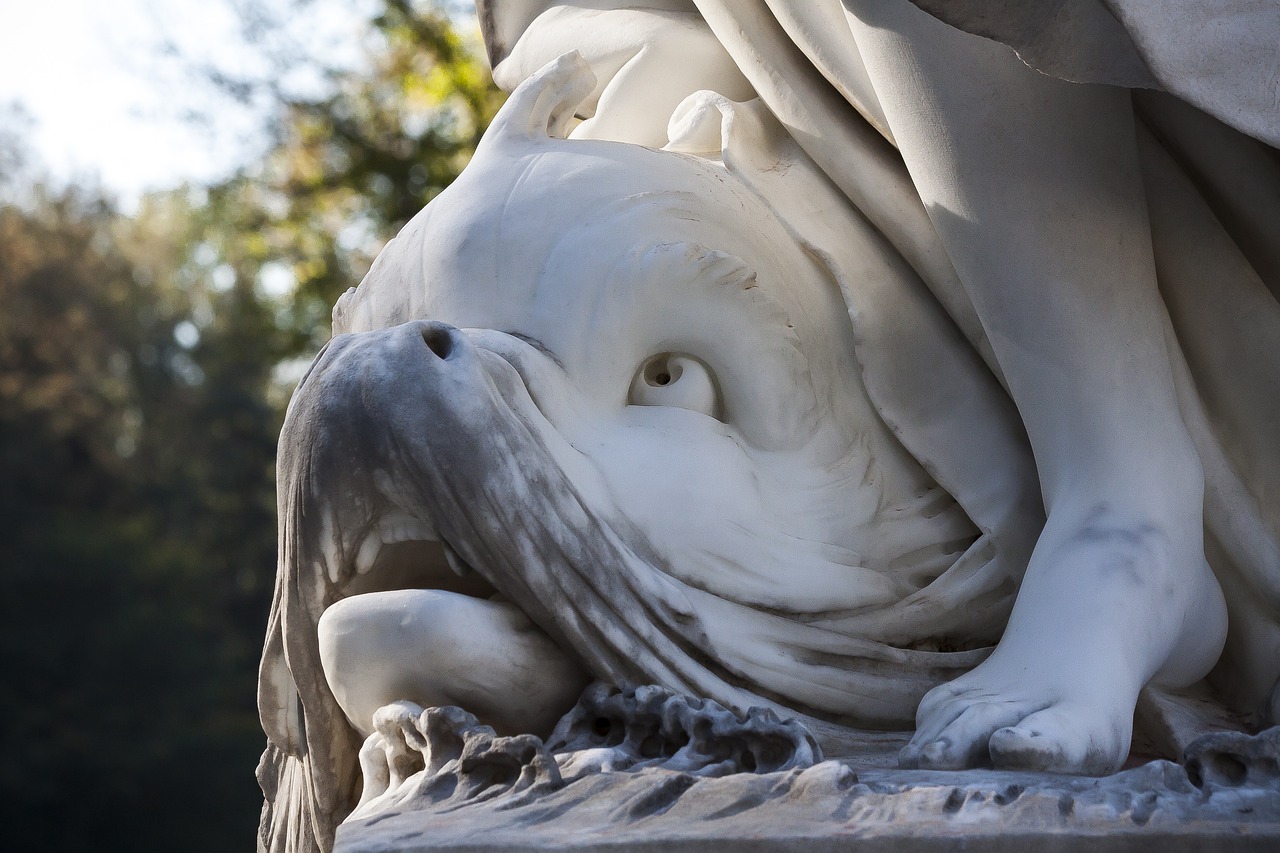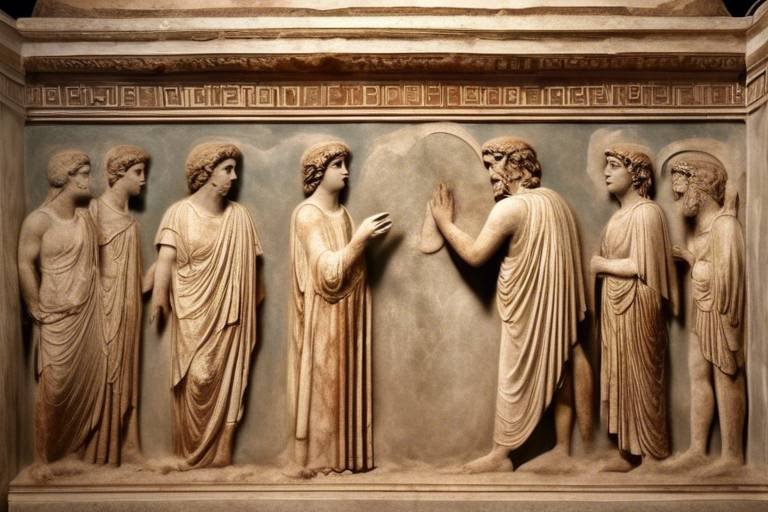The Mystery of the Elgin Marbles - Cultural Heritage
The Elgin Marbles, also known as the Parthenon Marbles, stand as a testament to the rich cultural heritage of ancient Greece. These exquisite marble sculptures, originally part of the Parthenon temple in Athens, have captivated art enthusiasts and historians for centuries with their intricate craftsmanship and historical significance. However, the mystery surrounding their removal from Greece has sparked intense debates and controversies that continue to echo through the halls of museums and the corridors of diplomacy.
Imagine a grand archaeological site where each piece tells a story, where each sculpture whispers secrets of a bygone era. The Elgin Marbles, crafted in the 5th century BC by skilled hands, depict scenes from Greek mythology and history, offering a window into the artistic prowess and cultural beliefs of ancient Greeks. These masterpieces, once adorning the Parthenon, were later acquired by Lord Elgin in a controversial move that would forever alter their fate.
The ownership disputes surrounding the Elgin Marbles have become a battleground of historical narratives and legal claims. Greece asserts its rightful ownership of these cultural treasures, citing their removal during a period of Ottoman occupation as an act of cultural theft. On the other hand, the British Museum maintains its possession of the Marbles, arguing that their acquisition was legitimate and that they serve as a global heritage accessible to all.
As calls for repatriation grow louder, the debate intensifies, raising fundamental questions about the preservation of cultural heritage and the sovereignty of nations over their artifacts. Advocates for the return of the Elgin Marbles to Greece argue for the restoration of historical justice and the recognition of a nation's right to reclaim its cultural patrimony. The movement for repatriation underscores the ethical imperative of respecting the origins and significance of cultural artifacts.
Amidst the clash of opinions and legal battles, the fate of the Elgin Marbles remains uncertain, casting a shadow over cultural diplomacy and international relations. The dispute over these marbles has transcended borders, shaping narratives of cultural exchange and raising awareness about the complexities of heritage conservation in a globalized world.
Conservation efforts face daunting challenges as experts strive to protect and display the Elgin Marbles in a manner that ensures their longevity and accessibility to the public. Factors such as environmental conditions, restoration techniques, and ethical considerations play crucial roles in determining the future of these iconic sculptures and their impact on future generations.
The diverse spectrum of public opinion surrounding the Elgin Marbles controversy reflects the complex interplay of historical, cultural, and political factors at stake. Art historians, politicians, activists, and ordinary citizens offer a range of perspectives, each contributing to the ongoing dialogue on the significance and ownership of cultural heritage.
Looking ahead, the future of the Elgin Marbles hinges on evolving attitudes towards cultural heritage, restitution policies, and collaborative efforts in the art world. The resolution of this longstanding debate will shape the course of cultural diplomacy and set precedents for the handling of disputed artifacts in an increasingly interconnected global society.

History of the Elgin Marbles
The history of the Elgin Marbles dates back to the 5th century BC, during the height of classical Greek civilization. These exquisite marble sculptures were originally part of the Parthenon, a temple dedicated to the goddess Athena in Athens. Crafted by renowned sculptors such as Phidias, the Elgin Marbles depicted various scenes from Greek mythology and history, showcasing the artistic prowess and cultural richness of ancient Greece.
In the early 19th century, the controversial acquisition of the Elgin Marbles took place when Thomas Bruce, the 7th Earl of Elgin, removed a significant portion of the sculptures from the Parthenon. Lord Elgin claimed to have obtained permission from the Ottoman Empire, which then controlled Greece, to transport the marbles to England. The sculptures were later displayed in the British Museum, where they have remained a source of fascination and contention for centuries.
The presence of the Elgin Marbles in the British Museum has sparked debates over cultural heritage, ownership rights, and the ethics of removing artifacts from their country of origin. While some argue that Lord Elgin's actions saved the sculptures from further deterioration or destruction, others view the removal as a contentious act that deprived Greece of a vital part of its cultural legacy.

Significance of the Elgin Marbles
The Elgin Marbles hold a profound significance in the realm of art and culture, representing a pinnacle of classical Greek craftsmanship and storytelling. These marble sculptures, originally created in the 5th century BC, are renowned for their exceptional artistry and intricate detailing, showcasing scenes from Greek mythology and historical events. Each piece offers a glimpse into the rich cultural tapestry of ancient Greece, immortalizing the beliefs, values, and narratives of a bygone era.
Moreover, the Elgin Marbles serve as a testament to the enduring legacy of Greek civilization, embodying the essence of artistic expression and intellectual prowess that defined the ancient world. These masterpieces not only captivate the imagination with their beauty and symbolism but also serve as invaluable educational tools, offering insights into the artistic techniques and societal norms of the past.

Ownership Disputes
The ownership disputes surrounding the Elgin Marbles stem from the contentious history of their removal from Greece by Lord Elgin in the early 19th century. Greece argues that the sculptures were unlawfully taken and should be returned to their country of origin, emphasizing their cultural and historical significance. On the other hand, the British Museum asserts its legal ownership of the Marbles, citing the permissions granted to Lord Elgin by the Ottoman Empire, which controlled Greece at the time of the removal.
Both Greece and the United Kingdom have presented compelling arguments to support their claims. Greece highlights the emotional connection of the Marbles to its heritage and the desire to reunite them with the remaining pieces in Athens. Conversely, the British Museum emphasizes the role of the Marbles in its collection as a global cultural asset, accessible to millions of visitors from around the world.
The ownership disputes have sparked debates on the ethical implications of cultural appropriation and the responsibilities of museums in preserving and showcasing artifacts from other nations. The case of the Elgin Marbles serves as a focal point for discussions on the balance between cultural heritage protection and the sharing of art for educational and public benefit.
Efforts to resolve the ownership disputes have included diplomatic negotiations, legal challenges, and public campaigns advocating for the repatriation of the Marbles. The complex nature of the issue reflects broader questions about the ownership and stewardship of cultural objects with contested histories, inviting reflection on the intersection of art, politics, and national identity.

Calls for Repatriation
When it comes to the Elgin Marbles, the calls for repatriation echo loudly across the art world. Advocates and activists are fervently pushing for the return of these ancient treasures to their homeland in Greece. The argument is not just about physical possession but revolves around the deeper issue of cultural heritage preservation and the right of nations to reclaim their historical artifacts.
One of the primary arguments supporting repatriation is the moral imperative to right historical wrongs. Many believe that the removal of the Elgin Marbles from Greece was an act of cultural theft, depriving the country of its rich heritage. Returning these sculptures would not only rectify past injustices but also signal a commitment to respecting the cultural sovereignty of nations.
Furthermore, the repatriation of the Elgin Marbles is seen as a symbolic gesture of goodwill and cooperation between nations. By returning these artifacts to Greece, it is viewed as a step towards fostering stronger diplomatic ties and promoting cultural exchange on a global scale. The act of repatriation is not just about returning objects but also about nurturing relationships and building trust among nations.
On the other hand, critics of repatriation argue that the Elgin Marbles have been safeguarded and displayed in the British Museum for centuries, where they have become a part of a broader cultural narrative. They contend that removing these sculptures from their current location would disrupt the historical context in which they have been situated for so long.
However, the counterargument to this is that advancements in technology and museum practices now allow for the creation of high-quality replicas, enabling institutions to preserve the integrity of the originals while facilitating their return to their places of origin. This compromise seeks to balance the interests of both preserving cultural heritage and respecting the rights of nations to control their own artifacts.
In conclusion, the calls for repatriation of the Elgin Marbles are deeply rooted in the principles of cultural heritage preservation, national sovereignty, and ethical stewardship of historical artifacts. The ongoing debate highlights the complexities of balancing the interests of different stakeholders while striving to uphold the values of respect, cooperation, and mutual understanding in the global art community.

Impact on Cultural Diplomacy
The impact of the Elgin Marbles controversy on cultural diplomacy cannot be understated. This long-standing dispute between Greece and the United Kingdom has reverberated across international relations, raising important questions about the ethical considerations of cultural heritage and ownership. The possession of these ancient sculptures by the British Museum has sparked debates on the role of museums in preserving and showcasing artifacts from other nations. It has also highlighted the power dynamics at play in cultural exchange and the challenges of balancing national pride with global cooperation.

Conservation and Display Challenges
Conservation and display challenges surrounding the Elgin Marbles present a complex set of obstacles that require meticulous attention and expertise. The delicate nature of these ancient marble sculptures demands specialized care to ensure their longevity and preservation for future generations. Conservation efforts involve a delicate balance between maintaining the original integrity of the artworks and preventing further deterioration caused by environmental factors.
One of the primary challenges in conserving the Elgin Marbles lies in the selection of appropriate restoration techniques. The intricate details and fragile surfaces of the sculptures require skilled conservators to employ gentle and precise methods to address issues such as surface erosion, discoloration, and structural instability. The use of advanced technologies and materials plays a crucial role in enhancing the conservation process while maintaining the authenticity of the artifacts.
Environmental conditions also pose significant challenges to the display of the Elgin Marbles. Factors such as temperature fluctuations, humidity levels, and exposure to light can impact the stability and condition of the sculptures over time. Implementing controlled climate systems and protective measures within exhibition spaces is essential to mitigate the effects of these environmental variables and safeguard the artworks from potential harm.
Furthermore, ensuring public accessibility to the Elgin Marbles while prioritizing their conservation presents a unique dilemma. Balancing the desire for widespread viewing opportunities with the need to protect the sculptures from excessive handling and exposure requires thoughtful planning and innovative display solutions. Museums and cultural institutions face the challenge of striking a harmonious balance between showcasing these remarkable artifacts and safeguarding their long-term preservation.
In addressing the conservation and display challenges associated with the Elgin Marbles, collaboration among experts in the fields of art conservation, museum management, and cultural heritage plays a vital role. By fostering interdisciplinary partnerships and embracing best practices in conservation ethics, institutions can navigate the complexities of preserving these invaluable cultural treasures while promoting public engagement and appreciation.

Public Opinion and Engagement
The controversy surrounding the Elgin Marbles has sparked a wide range of opinions and engaged people from various backgrounds. Art historians often debate the ethical implications of the marbles' removal from Greece, questioning the legitimacy of Lord Elgin's acquisition. Some argue that the sculptures should be returned to their country of origin to preserve their cultural integrity and historical significance. On the other hand, there are those who believe that the British Museum provides a global platform for the marbles, allowing people from around the world to appreciate and study these ancient artworks.
Politicians play a crucial role in shaping public opinion on the repatriation of cultural artifacts. Diplomatic discussions between Greece and the UK have highlighted the complexities of international relations and the sensitivity of heritage issues. While some politicians advocate for the return of the Elgin Marbles as a gesture of goodwill and respect for Greece's cultural heritage, others prioritize the importance of maintaining the marbles in a museum setting for educational purposes.
Activists and cultural heritage preservationists actively engage in campaigns and protests to raise awareness about the Elgin Marbles dispute. Their efforts aim to mobilize public support for repatriation initiatives and challenge the institutional practices of museums in holding onto contested artifacts. Through social media campaigns, petitions, and public exhibitions, these advocates strive to amplify the voices of communities seeking the return of their cultural treasures.
Among the general population, opinions on the Elgin Marbles vary widely. While some individuals view the marbles as symbols of cultural imperialism and colonialism, others appreciate them as valuable contributions to the world's artistic heritage. Public engagement with the issue often leads to discussions about restitution policies, the responsibilities of museums in safeguarding cultural objects, and the implications of historical injustices on present-day cultural diplomacy.

Future of the Elgin Marbles
As we ponder the future of the Elgin Marbles, one can't help but wonder about the potential resolutions that lie ahead for these iconic cultural artifacts. The debate surrounding their ownership and display has sparked fervent discussions globally, prompting a reevaluation of how we perceive and protect our shared cultural heritage.
One possible outcome for the Elgin Marbles could be a collaborative agreement between Greece and the British Museum, where the sculptures are shared between the two nations for alternating display periods. This arrangement could satisfy both parties' claims to the marbles while promoting cultural exchange and understanding.
Alternatively, the growing calls for repatriation may lead to the eventual return of the Elgin Marbles to Greece. This shift in ownership would signify a triumph for cultural heritage preservation and national sovereignty, setting a precedent for the restitution of other disputed artifacts around the world.
Moreover, advancements in digital technology offer innovative solutions for the preservation and accessibility of the Elgin Marbles. Virtual reality tours, interactive exhibits, and online databases could provide a new way for audiences to engage with these ancient sculptures, transcending geographical boundaries and enhancing public appreciation.
Ultimately, the future of the Elgin Marbles hinges on a delicate balance between historical significance, ethical considerations, and diplomatic negotiations. As we navigate this complex terrain, it is essential to prioritize mutual respect, transparency, and cooperation in finding a sustainable resolution that honors the legacy of these remarkable works of art.
Frequently Asked Questions
- What are the Elgin Marbles?
The Elgin Marbles are a collection of classical Greek marble sculptures originally from the Parthenon and other ancient buildings on the Acropolis of Athens.
- Why are the Elgin Marbles controversial?
The controversy surrounding the Elgin Marbles stems from their removal from Greece by Lord Elgin in the early 19th century and their subsequent display in the British Museum, leading to ownership disputes and calls for repatriation.
- Who claims ownership of the Elgin Marbles?
Both Greece and the United Kingdom claim historical and legal rights to the Elgin Marbles, leading to a longstanding debate over their rightful ownership.
- What is the significance of the Elgin Marbles?
The Elgin Marbles hold immense artistic and cultural value, showcasing exquisite craftsmanship and depicting scenes from Greek mythology and history, making them significant cultural treasures.
- Why is there a movement for the repatriation of the Elgin Marbles?
Advocates for repatriation argue for the return of the Elgin Marbles to Greece to preserve cultural heritage and uphold the rights of nations to reclaim their cultural artifacts.
- How have the Elgin Marbles influenced cultural diplomacy?
The dispute over the Elgin Marbles has impacted international relations and cultural exchange, raising ethical questions about the display and ownership of cultural artifacts between nations.



















